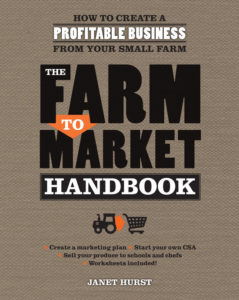Excerpted from The Farm to Market Handbook by Janet Hurst.
Putting the Plan to Work
Review your marketing plan with your team. It is important to have everyone on board and moving in the same direction. After the plan is written, there will be a document to go to, to assist in decision-making processes. Although nothing is set in stone, proceed with caution if there is a shift in the overall objectives of the business, and make sure that the shift does not divert the farm from the overall goal of making a profit. This may mean letting go of something, and that can be hard to do. It is important to lead with the head and not the heart in these matters.
The Markets
With this information in hand, you are ready to take a look at the various types of markets and how they can work for you. Traditional marketing routes include:
Farmers’ Markets:
These are often community-sponsored events that usually take place one or two days a week. Participating in farmers’ markets is a good way to begin to market your products. Many farmers prefer this method for several reasons, number one being getting instant feedback—a little praise goes a long way. If customers are excited, farmers’ markets can fuel the grower’s fire. Cash sales are another benefit of farmers’ markets. Many customers come prepared with cash when they visit a market. Cash on the barrel head is still a good way of doing business. Farmers also develop relationships and build trust with their customers at farmers’ markets.
Community Supported Agriculture:
CSA is a method of marketing that has customers buying “shares” of the anticipated crops. Then each week throughout the growing season, they are given a box full of vegetables. The box contains vegetables that are available that week, some weeks will contain more, others less. The idea is that the customer is sharing some of the risk of farming. If it is a bountiful year, the customers will receive a greater amount of goods. If it is a dry year, then they will receive less. The advantage to this type of arrangement is that the customers pay upfront for the season, so operating capital is at hand when it is most needed. The downside can be that during a lean year, it is hard to get customers to buy into the program a second time. It is also a little hard to have all the payments upfront and most likely spent, while working the rest of the summer. Even though payment has been made, sometimes it is good to have rewards coming in along the way. Those who sell in this manner work for years to develop a loyal following and find their CSA to be a necessary, valuable source of income for their farm.
Brokers:
Brokers can represent your farm, selling your produce for a commission. Often, these people have developed relationships with chefs or retail outlets. They have a customer base to work from, which is a huge help to new farmers. Chances are, the farmer has little time to go out and develop these relationships, especially in the first few seasons of starting up the operation. A broker has the inroads already established and if his or her reputation is good, then this can open many doors that would otherwise be difficult to access. Of course, there is a fee for their service. Sometimes, the broker buys the goods from the farm and then simply marks them up. This is a good way to do business, with the farmer setting the price first. Remember to be a price maker, not a price taker, if at all possible. This type of arrangement works well for chefs because they can tell the broker what they are looking for and avoid a parade of farmers entering their kitchens. Brokers work particularly well for those who would rather be on the farm than entering into the sales arena. For many farmers, selling is their weakest point. A broker will handle the transactions and chances are that selling is his or her strong suit.
Co-ops:
Co-ops were a popular idea in the 1970s with their small storefront operations working in harmony to provide vending space for multiple sellers. This concept allowed the vendors to share expenses, such as rent, utilities, advertising, etc., while providing a market space for the members. Work share agreements allowed the vendors to be on the sales floor for a day or two a week, while other members worked the other days. This type of arrangement can still work today as long as there is a firm understanding (documented) of who will handle the day-to-day operations, how bills will be paid, how farmers will be reimbursed, etc. A co-op arrangement can be a stretch if this type of business is with family or close friends. Remember to keep business separate from your personal life and have a structured method of operation.
Traditional retail outlets:
Some farmers prefer to deal directly with produce managers in larger supermarkets. While this may be possible for those growers with a large volume of production, often the small farmer is excluded from this market due to lack of available goods. There are also regulations to consider. Most large stores ask for liability insurance and food safety plans. The store must add its markup, typically 40 to 100 percent, to your price. Keep this in mind when considering this option.
Farm to School programs:
This seems like a no-brainer. We want healthy children, so the best medicine we can give them is healthy, nutritious foods. If we feed them chemically laden food, then we will pay for this decision with extra medical bills and more health concerns. School systems are coming on board with the Farm to School program, and there is growth in this industry annually. Perhaps selling your produce to the area school system will open a new market for you. Set up a time to visit with school administrators. Have your ducks in a row and present your ideas in a confident, businesslike manner. Take examples of Farm to School program material throughout the country for review. Start a conversation at the PTA, see where it all goes.
- Continued list in Farm to Consumer Handbook.
You may also enjoy these excerpts from The Farmers Market Handbook:
This excerpt has been reprinted with permission from The Farm to Market Handbook by Janet Hurst and published by Voyager Press, 2014.











